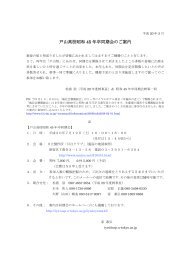Hofstadter butterflies in a modulated magnetic field - APS Link ...
Hofstadter butterflies in a modulated magnetic field - APS Link ...
Hofstadter butterflies in a modulated magnetic field - APS Link ...
- No tags were found...
Create successful ePaper yourself
Turn your PDF publications into a flip-book with our unique Google optimized e-Paper software.
IYE et al. PHYSICAL REVIEW B 70, 144524 (2004)of , the dips at half-<strong>in</strong>teger and <strong>in</strong>teger ’s change over<strong>in</strong> depth. The trace C, which corresponds to = 1 2, is shiftedby a half-period from the orig<strong>in</strong>al one (trace A). Theevolution with thus goes on and completes one cycle atthe trace E.Figure 13 shows a similar set of traces for sample B,represent<strong>in</strong>g the stripe <strong>field</strong> case. 24 Although the overall evolutionof the trace with is similar to Fig. 12, there are twodist<strong>in</strong>ct features to be noted. First, compar<strong>in</strong>g the traces B <strong>in</strong>the two figures, the relative amplitude of oscillation at thepo<strong>in</strong>t of half-periodicity for sample B = 1 4is muchsmaller than the correspond<strong>in</strong>g one for sample A = 1 4. Secondly,although difficult to see directly from Figs. 12 and 13,there is a substantial difference <strong>in</strong> the way the depth of <strong>in</strong>tegerdips (and that of the half-<strong>in</strong>teger dips) evolves with or, between the two cases. This is more clearly seen <strong>in</strong> Fig.14, which shows the shift <strong>in</strong> the transition temperature with (or ) for the two cases. The values of T c were obta<strong>in</strong>edfrom the experimentally measured changes <strong>in</strong> resistance byconvert<strong>in</strong>g them with use of the resistive transition curveRT. The amplitude T c is consistent with Eq. (8) with030 nm. The difference <strong>in</strong> T c by a factor of 2 betweensamples A (checkerboard) and B (stripe) is chiefly due to thedifference <strong>in</strong> the unit-cell area a 2 . The curves <strong>in</strong> the figurerepresent the shape of the bottom edge of the correspond<strong>in</strong>g<strong>Hofstadter</strong> spectra, seen on the front-right facet of the stereoplot <strong>in</strong> Fig. 8. The solid symbols and the solid curve correspondto =0. The open symbols and the dashed curve correspondto = 1 2. The agreement between the experimentaldata and the calculated curves <strong>in</strong>dicates that the present systemof a superconduct<strong>in</strong>g network with <strong>magnetic</strong> decorationcaptures some of the characteristic features of the <strong>Hofstadter</strong>spectra under the spatially <strong>modulated</strong> <strong>magnetic</strong> <strong>field</strong> discussed<strong>in</strong> this paper.IV. CONCLUSIONWe have calculated the <strong>Hofstadter</strong> butterfly spectra for a2D tight-b<strong>in</strong>d<strong>in</strong>g square lattice subjected to a spatially <strong>modulated</strong><strong>magnetic</strong> <strong>field</strong>. The correspond<strong>in</strong>g experimental situationsare realized by fabricat<strong>in</strong>g a superconduct<strong>in</strong>g wire networkdecorated with a mesoscopic ferromagnet array. Theevolution of Little-Parks oscillation with the amplitude of the<strong>modulated</strong> <strong>magnetic</strong> <strong>field</strong> <strong>in</strong> these samples exhibits characteristicfeatures of the two different types of modulation, thatis, checkerboard and stripe pattern. These results establishthe consistency of the calculated <strong>Hofstadter</strong> spectra with thechange <strong>in</strong> T c , although there is a fundamental limitation thatonly the edge of the spectrum can be probed by the superconduct<strong>in</strong>gsystem.Control of flux distribution <strong>in</strong> the superconduct<strong>in</strong>g networkby mesoscopic <strong>magnetic</strong> decoration may prove to be auseful technique <strong>in</strong> the development of devices us<strong>in</strong>g superconduct<strong>in</strong>gflux quanta. It should be of much <strong>in</strong>terest to explorethe vortex dynamics <strong>in</strong> these artificial potential landscapes.More generally, the mesoscopic ferromagnet/superconductor hybrid system may provide a wider arena forthe exploration of vortex physics and possible device applications.ACKNOWLEDGMENTSWe thank Professor D. Yoshioka, Professor H. Aoki, ProfessorH. Fukuyama, Professor S. Maekawa, Professor F.Nori, and Dr. M. Kosh<strong>in</strong>o for helpful conversations. Thiswork has been supported by a Grant-<strong>in</strong>-Aid for COE Research“Quantum Dot and Its Application” (No. 12CE2004),and by a Grant-<strong>in</strong>-Aid for Scientific Research (No.13304025), from the M<strong>in</strong>istry of Education, Culture, Sports,Science and Technology (MEXT), Japan.*Electronic address: iye@issp.u-tokyo.ac.jp1 D.R. <strong>Hofstadter</strong>, Phys. Rev. B 14, 2239 (1976).2 G.H. Wannier, Phys. Status Solidi B 88, 757 (1978).3 F.H. Claro and G.H. Wannier, Phys. Rev. B 19, 6068 (1979).4 Y. Hatsugai and M. Kohmoto, Phys. Rev. B 42, 8282 (1990).5 Ch. Kreft and R. Seiler, J. Math. Phys. 37, 5207 (1996).6 D.J. Thouless, M. Kohmoto, M.P. Night<strong>in</strong>gale, and M. den Nijs,Phys. Rev. Lett. 49, 405 (1982).7 A.H. MacDonald, Phys. Rev. B 28, 6713 (1983).8 P. Lederer, D. Poilblanc, and T.M. Rice, Phys. Rev. Lett. 63,1519 (1989).9 Y. Hasegawa, Y. Hatsugai, M. Kohmoto, and G. Montambaux,Phys. Rev. B 41, 9174 (1990).10 C. Albrecht, J.H. Smet, K. von Klitz<strong>in</strong>g, D. Weiss, V. Umansky,and H. Schweizer, Phys. Rev. Lett. 86, 147 (2001).11 B. Pannetier, J. Chaussy, R. Rammal, and J.C. Villegier, Phys.Rev. Lett. 53, 1845 (1985); see also B. Pennetier, <strong>in</strong> QuantumCoherence <strong>in</strong> Mesoscopic Systems, edited by B. Kramer, NATOAdvanced Study Institute Series Vol. 254 (Plenum Press, NewYork, 1991), p. 457.12 S. Alexander, Phys. Rev. B 27, 1541 (1983).13 R. Rammal, T.C. Lubensky, and G. Toulouse, Phys. Rev. B 27,2820 (1983).14 M.J. Higg<strong>in</strong>s, Y. Xiao, S. Bhattacharya, P.M. Chaik<strong>in</strong>, S. Sethuraman,R. Bojko, and D. Spencer, Phys. Rev. B 61, R894 (2000).15 C.C. Abilio, P. Butaud, Th. Fournier, B. Pannetier, J. Vidal, S.Tedesco, and B. Dalzotto, Phys. Rev. Lett. 83, 5102 (1999).16 M.A. Itzler, A.M. Behrooz, C.W. Wilks, R. Bojko, and P.M.Chaik<strong>in</strong>, Phys. Rev. B 42, 8319 (1990).17 M.A. Itzler, R. Bojko, and P.M. Chaik<strong>in</strong>, Phys. Rev. B 47, 14 165(1993).18 B. Doucot, W. Wang, J. Chaussy, B. Pannetier, R. Rammal, A.Vareille, and D. Henry, Phys. Rev. Lett. 57, 1235 (1986).19 S. Ito, M. Ando, S. Katsumoto, and Y. Iye, J. Phys. Soc. Jpn. 68,3158 (1999).20 M. Ando, S. Ito, S. Katsumoto, and Y. Iye, J. Phys. Soc. Jpn. 68,3462 (1999).21 Y. Nozaki, Y. Otani, K. Runge, H. Miyajima, B. Pannetier, J.P.Nozieres, and G. Fillion, J. Appl. Phys. 79, 8571 (1996).22 G.-Y. Oh, Phys. Rev. B 62, 4567 (2000).144524-8








